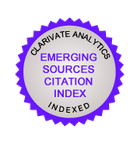Rate of hypovitaminosis D and association of plasma concentration of 25(OH)D with indicators of disease activity in patients with rheumatoid arthritis
https://doi.org/10.29235/1561-8323-2020-64-6-723-729
Abstract
About the Authors
A. V. RudenkoBelarus
Rudenko Alena V. – Ph. D. (Medicine), Associate professor
3, P. Brovka Str., 220013, Minsk
T. D. Tyabut
Belarus
Tyabut Tamara D. – D. Sc. (Medicine), Professor
3, P. Brovka Str., 220013, Minsk
A. E. Buglova
Belarus
Buglova Anna E. – Ph. D. (Medicine), Associate professor
3, P. Brovka Str., 220013, Minsk
G. A. Babak
Belarus
Babak Galina A. – Ph. D. (Medicine), Head of the Department
64, Nezavisimosti Ave., 220013, Minsk
P. M. Morozik
Belarus
Morozik Pavel M. – Ph. D. (Biology), Associate professor, Head of the Laboratory
27, Akademicheskaya Str., 220072, Minsk,
T. D. Borisenko
Belarus
Borisenko Tatiana D. – Ph. D. (Medicine), Head of the Laboratory
64, Nezavisimosti Ave., 220013, Minsk
References
1. Hilger J., Friedel A., Herr R., Rausch T., Roos F., Wahl D. A., Pierroz D. D., Weber P., Hoffmann K. A systematic review of vitamin D status in populations worldwide. British Journal of Nutrition, 2014, vol. 111, no. 1, pp. 23–45. https://doi.org/10.1017/s0007114513001840
2. Bellan M., Sainaghi P. P., Pirisi M. Role of Vitamin D in Rheumatoid Arthritis. Advances in Experimental Medicine and Biology, 2017, vol. 996, pp. 155–168. https://doi.org/10.1007/978-3-319-56017-5_13
3. Ishikawa L. L. W., Colavite P. M., de Campos Fraga-Silva T. F., Mimura L. A. N., França T. G. D., Zorzella-Pezavento S. F. G., Chiuso-Minicucci F., Marcolino L. D., Penitenti M., Ikoma M. R. V., Sartori A. Vitamin D Deficiency and Rheumatoid Arthritis. Clinical Reviews in Allergy and Immunology, 2017, vol. 52, no. 3, pp. 373–388. https://doi.org/10.1007/s12016-016-8577-0
4. Aletaha D., Neogi T., Silman A. J., Funovits J., Felson D. T., Bingham C. O., Birnbaum N. S., Burmester G. R., Bykerk V. P., Cohen M. D., Combe B., Costenbader K. H., Dougados M., Emery P., Ferraccioli G., Hazes J. M. W., Hobbs K., Huizinga T. W. J., Kavanaugh A., Kay J., Kvien T. K., Laing T., Mease P., Ménard H. A., Moreland L. W., Naden R. L., Pincus T., Smolen J. S., Stanislawska-Biernat E., Symmons D., Tak P. P., Upchurch K. S., Vencovsky J., Wolfe F., Hawker G. Rheumatoid arthritis classification criteria: An American College of Rheumatology/European League Against Rheumatism collaborative initiative. Arthritis & Rheumatism, 2010, vol. 62, no. 9, pp. 2569–2581. https://doi.org/10.1002/art.27584
5. Rizzoli R., Boonen S., Brandi M.-L., Bruyère O., Cooper C., Kanis J. A., Kaufman J.-M., Ringe J. D., Weryha G., Reginster J.-Y. Vitamin D supplementation in elderly or postmenopausal women: a 2013 update of 2008 recommendations from the European Society for Clinical and Economic Aspects of Osteoporosis and Osteoarthritis (ESCEO). Current Medical Research and Opinion, 2013, vol. 29, no. 4, pp. 305–313. https://doi.org/10.1185/03007995.2013.766162
6. Vanherwegen A. S., Gysemans C., Mathieu C. Regulation of Immune Function by Vitamin D and Its Use in Diseases of Immunity. Endocrinology and Metabolism Clinics of North America, 2017, vol. 46, no. 4, pp. 1061–1094. https://doi.org/10.1016/j.ecl.2017.07.010
7. Peterlik M., Cross H. S. Dysfunction of the vitamin D endocrine system as common cause for multiple malignant and chronic diseases. Anticancer Research, 2006, vol. 26, pp. 2581–2588.
8. Palmer M. T., Lee Y. K., Maynard C. L., Oliver J. R., Bikle D. D., Jetten A. M., Weaver C. T. Lineage-specific effects of 1,25-dihydroxyvitamin D(3) on the development of effector CD4 T cells. Journal of Biological Chemistry, 2011, vol. 286, no. 2, pp. 997–1004. https://doi.org/10.1074/jbc.m110.163790
9. Bemiss C. J., Mahon B. D., Henry A., Weaver V., Cantorna M. T. Interleukin-2 is one of the targets of 1,25-dihydroxyvitamin D3 in the immune system. Archives of Biochemistry and Biophysics, 2002, vol. 402, no. 2, pp. 249–254. https://doi.org/10.1016/s0003-9861(02)00082-6
10. von Essen M. R., Kongsbak M., Schjerling P., Olgaard K., Ødum N., Geisler C. Vitamin D controls T cell antigen receptor signaling and activation of human T cells. Nature Immunology, 2010, vol. 11, no. 4, pp. 344–349. https://doi.org/10.1038/ni.1851
11. Bragazzi N. L., Watad A., Neumann S. G., Simon M., Brown S. B., Much A. A., Harari A., Tiosano S., Amital H., Shoenfeld Y. Vitamin D and rheumatoid arthritis: an ongoing mystery. Current Opinion Rheumatology, 2017, vol. 29, no. 4, pp. 378–388. https://doi.org/10.1097/bor.0000000000000397
12. Di Franco M., Barchetta I., Iannuccelli C., Gerardi M. C., Frisenda S., Ceccarelli F., Valesini G., Cavallo M. G. Hypovitaminosis D in recent onset rheumatoid arthritis is predictive of reduced response to treatment and increased disease activity: a 12 month follow-up study. BMC Musculoskeletal Disorders, 2015, vol. 16, no. 1, pp. 53. https://doi.org/10.1186/s12891-015-0505-6
13. Patel S., Farragher T., Berry J., Bunn D., Silman A., Symmons D. Association between serum vitamin D metabolite levels and disease activity in patients with early inflammatory polyarthritis. Arthritis and Rheumatism, 2007, vol. 56, no. 7, pp. 2143–2149. https://doi.org/10.1002/art.22722
14. Lee Y. H., Bae S. C. Vitamin D level in rheumatoid arthritis and its correlation with the disease activity: a meta-analysis. Clinical and Experimental Rheumatology, 2016, vol. 34, no. 5, pp. 827–833.
15. Matsumoto Y., Sugioka Y., Tada M., Okano T., Mamoto K., Inui K., Habu D., Koike T. Relationships between serum 25-hydroxycalciferol, vitamin D intake and disease activity in patients with rheumatoid arthritis – tomorrow study. Modern Rheumatology, 2015, vol. 25, no. 2, pp. 246–250. https://doi.org/10.3109/14397595.2014.952487













































